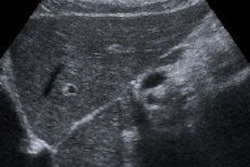Radiologists in China are getting more traction out of their CT liver protocols with the use of perfusion dual-source CT (DSCT) exams, taking a bite out of MRI's traditional superiority in the process.
For the imaging of focal liver lesions, perfusion CT can exceed the diagnostic capabilities of standard CT and sometimes even MRI, said Dr. Liu Hailing from Guangzhou General Military Hospital in Guangzhou, China.
"It can not only show anatomic morphological changes but also provide information on functional and metabolic changes such as blood supply conditions and blood-flow dynamics," Hailing said earlier this month at the International Congress of Radiology (ICR) in Shanghai.
Currently, diagnosis and differential diagnosis of hepatocellular carcinoma (HCC), liver metastases, and cavernous hemangioma all depend on ultrasound, MRI, and CT, he said, but perfusion DSCT is showing that it can often do a better job in the clinical setting. Hailing said he and his colleagues wanted to elucidate the difference between hepatocellular carcinoma, liver metastases, and hemangioma using perfusion DSCT.
The researchers examined 49 patients with liver disease using DSCT (Somatom Definition, Siemens Healthcare, Erlangen, Germany) and subsequently proved by pathology. There were 11 hepatocellular carcinoma lesions, 15 hepatic cavernous hemangiomas, and 23 metastatic tumors.
DSCT images were acquired at 8 seconds and at 64 seconds (delayed phase) following contrast administration. The raw data were analyzed to obtain time-density curves and other parameters, including hepatic blood flow (HBF), hepatic blood volume (HBV), mean transit time (MTT), hepatic arterial fracture (HAF), and permeability surface area product (PS).
The differences in HBF, HBV, MTT, HAF, and PS were statistically significant, Hailing said, and easy to appreciate on the color perfusion maps.
"Compared with normal liver, HBV and HAF in hepatocellular carcinoma increased significantly," he said. In addition, HBF also increased significantly.
As for differential diagnoses, HBF and HAF in the solid portions of the liver were significantly higher in the hepatocellular carcinoma group compared to those with hemangiomas and metastases.
In addition, "HBF [measurements] were significantly higher in adjacent parenchyma and HAF were significantly lower in the hepatocellular carcinoma and [metastasis] groups than in the hemangioma group," he said. Meanwhile, "PS was significantly higher in the [metastasis] group than in the [hemangioma] group."
Finally, mean transit times were significantly shorter and HAF measurements were significantly increased in the hepatocellular carcinoma group compared to patients with hemangiomas and metastases.
"Multiple perfusion parameters were very useful for the differential diagnosis of hepatic nodules from benign and malignant lesions by DSCT," he concluded.
By Eric Barnes
AuntMinnie.com staff writer
April 29, 2010
Related Reading
Volume helical shuttle CT perfusion identifies stroke patients, April 20, 2010
Perfusion CT handily distinguishes malignant neck nodes, January 25, 2010
CT of colorectal liver mets may predict survival, December 1, 2009
PET/CT directs head and neck cancer treatment, November 17, 2009
FDG-PET/CT scans spot head and neck cancer return, October 14, 2009
Copyright © 2010 AuntMinnie.com




















